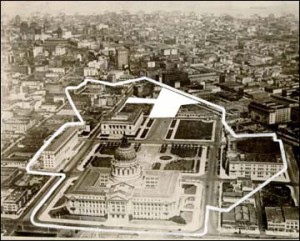In the center of San Francisco, there is a plaza with no benches. Its central feature, at the entrance of the plaza, is a unique fountain that was designed by Lawrence Halprin in 1975. The water shoots out at various angles from inside a sunken pit, filled with large granite slabs. It’s a design that kind of pulls you in and invites you to take the steps down to the water and climb in between the hulking stones. And that’s part of the problem.
In 2004, radio producer Ben Temchine, created a really fantastic documentary of UN Plaza, called “The Biography of 100,000 Square Feet” that first aired on my first radio program “Invisible Ink” in May of 2004. (Yep another “invisible” show.) The documentary really takes a hard look at UN Plaza when it was really at its worst and asks the question, is there a point where the good intentions and idealism of a design become so removed from reality that it actually borders on negligence?
I was down at UN Plaza today (November 17, 2011), recording the fountain and taking pictures. The arts market was being set up and the water was flowing in the fountain that was marred by a bit of trash circling in the eddies, but nothing too grotesque or unexpected. The yellow chain that cordoned off the fountain in 2004 is gone. And this morning, with the market being set up, I got a much stronger feel for the intention of the plaza than was evident when it was at its worst. But the big issues were still plain to see.
The Landscape Architect, Lawrence Halprin, who designed UN Plaza and is featured in the piece, died in 2009. If this is your first exposure to Halprin, I really recommend you look him up and check out his other work. He is absolutely revered in much of the landscape architecture community and the very principles of interactivity and engagement that worked to the detriment of UN Plaza, yielded stunningly successful results in other places. It’s worth exploring more of his legacy.




Comments (5)
Share
Hey there, Roman,
Thanks for calling me a big nerd. Loved it! Right back atcha!
Love this fountain! I have very fond memories of swimming in it at the gay pride parade when I was little, feeling transported by the bizarre nature of the structure.
Maybe i am late for this comment, but i don’t think to change the Plaza, i think they had to change the people ther. The people in the plaza is the thing thats wrong and not working and yes i know you can’t change peoples you can only to the thing they did an put cops ther but i don’t think this helps someone cause who is ther if not the poor, homeless and the drug users? Who benefits frome a plaza with no peoples?
Such a well-investigated and honest conversation about this space. Thank you!!!!
I listened to this and looked at the pictures & thought “That sounds like Skyline Park” in Denver. And sure enough, Halprin designed that too. And it was a haven for drug use, sexual assault, unruly skateboarders, trash,etc. Plus concerns about waste of water in an arid climate. And the arguments were much the same. There was no problem with the design, it was all the fault of the City for not appreciating what it had and maintaining it properly.
And I wonder if there are more examples in more cities. If very similar designs fail in very similar ways in multiple locations, perhaps the problem IS the design. That it was done because that is what the designer liked & did, not because it was the right choice for the space. Maybe its a lack of adaptability by Halprin. Maybe the City chose a design based on reputation not suitability. Maybe both.
San Francisco apparently kept theirs. Denver filled it in, planted some grass, put in a paved plaza (and like San Francisco) a small permanent police presence. Now it hosts Christmas markets, beer gardens, and so on, and hardly anyone remembers the piles of concrete and sandstone full of dark hiding places and sometimes water and fountains.